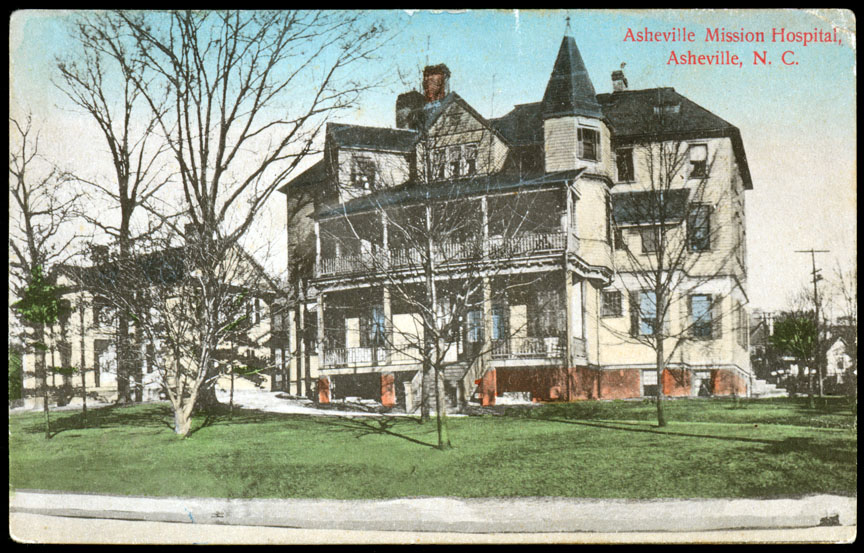Mission Hospital opened on South Main Street (present-day Biltmore Avenue) near Hilliard Avenue in October 1885. Over the next seven years, it would expand and relocate four times. Its initial facility was a small cottage, consisting of five rooms. According to the 1985 book, One Hundred Years of Service: Memorial Mission Hospital, 1885-1985, edited by Mrs. William F. Taylor, the first patient was admitted on Oct. 17, 1885.
The hospital was organized by the women of the Flower Mission, an auxiliary of the state branch of the Women’s Christian Temperance Union. Anna Woodfin, Fanny Patton, Rose Chapman and Mrs. W.C. Carmichael are frequently cited as the group’s four most prominent and influential figures.
On Jan. 29, 1886, The Asheville Citizen updated its readers about the facility’s progress. The report stated that Mission Hospital, “organized in Asheville for charitable purposes … will eventually be made self sustaining by caring for paid patients[.]” The article went on to note the recent arrival of Dr. W.L. Hilliard, who had joined Dr. J.A. Watson at the infirmary. The paper declared: “This gives a most efficient corps of medical attendance, and we hope the ladies will receive all needed encouragement in the good work they are doing.”
There were no guarantees, however, that the hospital would be able to sustain itself. On Nov. 13, 1886, Dr. Samuel Westray Battle, the chief of medical staff, delivered remarks to the organization’s all-woman board of managers (see “Asheville Archives: ‘More than a citizen,’” Sept. 26, 2017, Xpress). In his comments, published on Nov. 17, 1886 in The Asheville Citizen, Battle stated:
“To those acquainted with the workings of larger institutions in populous and wealthy cities [Mission Hospital] may seem a very small affair, but we are a small community and it speaks volumes for the ladies of Asheville whose charitable inspirations gave life to the hospital, and only those practically interested in the details of such work can fairly appreciate the difficulties to be surmounted. When we consider that this useful institution, beyond the support given by the county commissioners, depends entirely for its existence upon charity bestowed from day to day, it must be a source of gratification and pleasure to the good citizens of Asheville and its visitors to feel that they are contributing to the success of such a humane work. It is to be hoped that the good work will go on.”
In the following day’s paper, the urgent need to guarantee the hospital’s permanence was stated more directly by an unnamed associate:
“[T]he Mission Hospital was organized by ladies of Asheville and nobly seconded by the medical faculty. The foundation was laid upon broad, unselfish christian charity; the structure was erected by voluntary contribution and unpaid services. We will not say unrewarded services, because, to such minds and hearts, the consciousness of such contribution to the cause of humanity is ampler compensation than money can give. …
“We stated a few days ago in a communication on the subject how noble had been the response of the people; how the tradesmen had reduced their prices; how generous had been the druggists in their charges for medicine; how self-sacrificing individuals had been in their tender of personal service; and also how liberal the community had been in their pecuniary contributions. It is mostly upon these that the perpetuity of the Hospital depends.
“Yet the Hospital must now be regarded as a permanent institution. … The Hospital is one of the marks of advanced humanity. Illustrating its usefulness, we cannot now deny its blessings or ignore its influence. It must be sustained. But its resources must be made more assured. It must cease to depend so largely upon the precarious condition of individual contribution. …
“We have no complaint to make of the contribution by the county. Indeed, we thank the authorities for a certain degree of boldness in recognizing the Hospital as the subject of public interest, whose action has challenged some very illiberal criticism. …
“What the county authorities have done, the city authorities should have long since done. The responsibility upon them is the greater. The subjects of relief will be always more numerous from the town than from the country. Let the city authorities make a monthly appropriation not less than that made by the county. It is not the question whether they can afford it. They can do it. But they cannot ignore that which is a pressing duty. The Hospital is a fixed fact. It must be sustained; and the public authorities must take their share of the duty.”
On Dec. 17, 1892, after much resistance from Asheville’s Board of Alderman, Mission Hospital opened its new facility on the corner of Charlotte and Woodfin streets. According to One Hundred Years of Service, the building was equipped with two large wards, six private rooms, a kitchen and dining room. The book goes on to state: “It was the first [facility] in North Carolina built for hospital purposes, as all earlier ones had been remodeled dwellings.”
The 1892 building was torn down and replaced in 1923. Mission continued operating at its Charlotte and Woodfin location until 1954.
Editor’s note: Peculiarities of spelling and punctuation are preserved from the original document.



Was the building built in 1923 the one that currently stands at 70 Woodfin Place?
Indeed it is. Thanks for the comment/question.
Thank you for the response. The history of this is very interesting. I’m a 25yr old Asheville native. I remember St. Joseph, but I had never thought about before then. I am amazed at how charitable it was in the beginning.